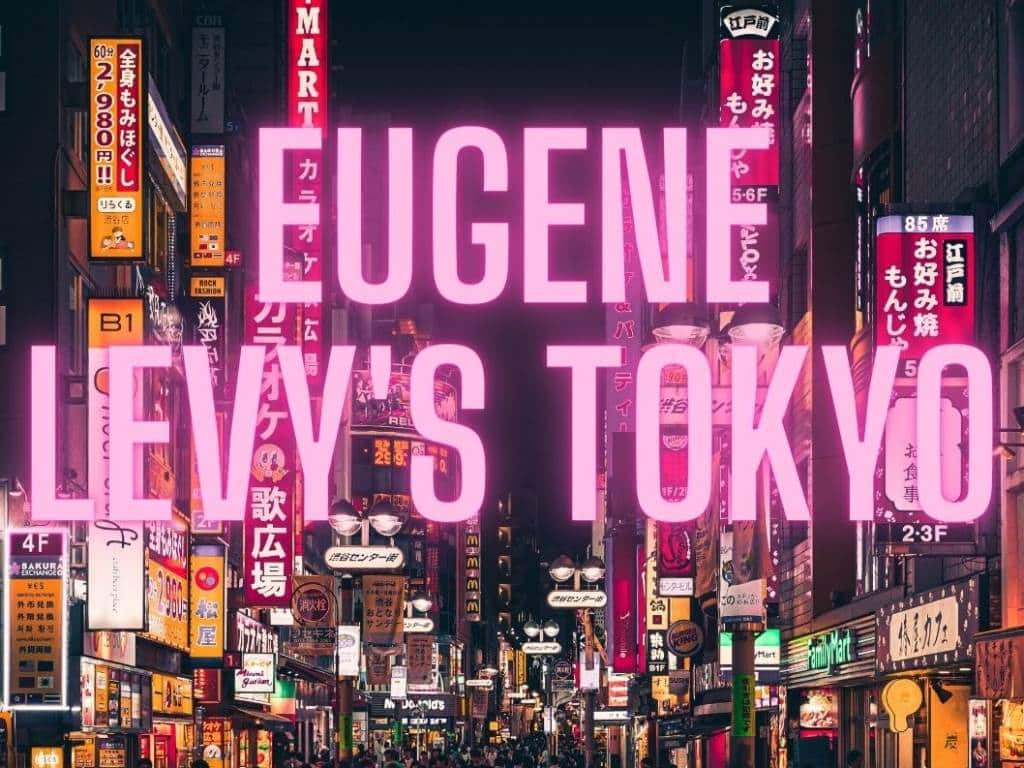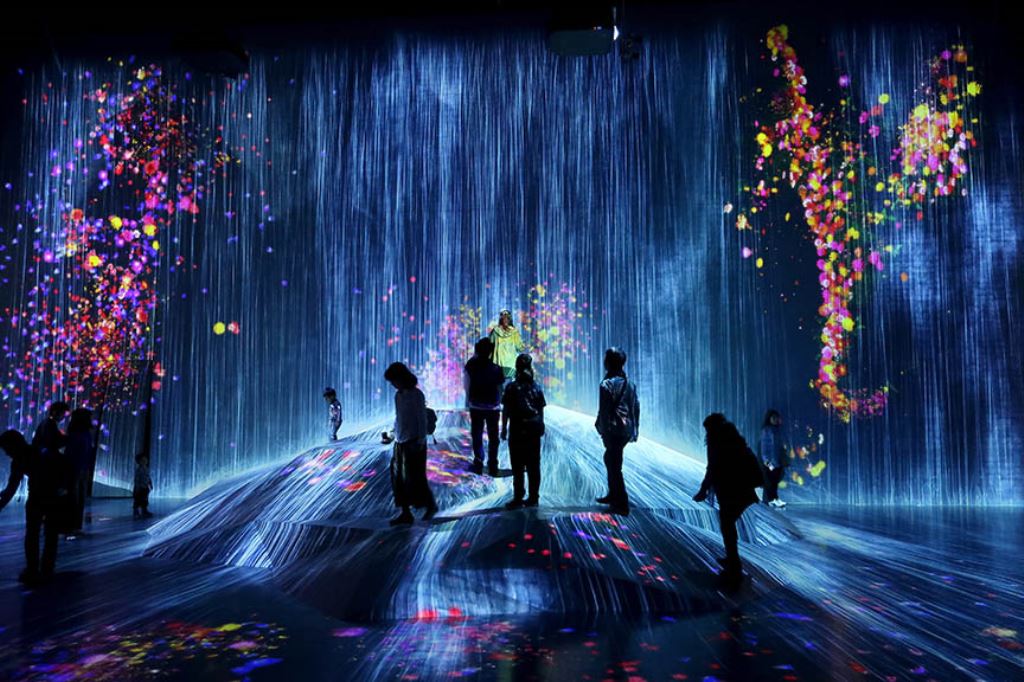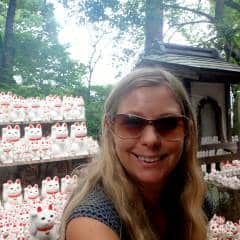- The Best Areas to Stay in Kyoto – On Your First Trip - 20 April 2024
- The 9 Chain Restaurants I Live On in Japan - 17 April 2024
- 10 Things Not Miss in Nagoya’s Endo-Ji Shopping Street - 11 April 2024
In Apple TV’s recent show The Reluctant Traveler, actor Eugene Levy travels the world like a fish out of water – but even he fell in love with Tokyo by the end of his trip. But where exactly did he visit?
We’ve put together a list of exactly how to do Tokyo like Eugene Levy – including the hotel he stayed in and the amazing art restaurant he visited.

Eugene’s Tokyo Hotel
Levy stayed at the very beautiful HOSHINOYA Tokyo Hotel close to Tokyo’s Imperial Palace.
The 17-story building describes itself as a contemporary ryokan and it combines the look and furnishings of a traditional ryokan (or inn) with all the modernity of an upscale hotel.
Each floor, which is only accessible to the guests staying on it, acts like a small hotel within the hotel with six stunning rooms and a communal space where you find tea and other refreshments daily – just like a traditional ryokan.

Of course, the hotel has a hot spring bath – and I’m surprised the show didn’t see Eugene taking part in traditional nude bathing, as that can put even those of us who have been to Japan a few times out of our comfort zone! But I guess that would have been a bit tricky to film.
You can also book other traditional activities on-site including a tea ceremony and rooftop sword training.
If you watched the rest of the show you’ll know that the hotels Eugene stayed in were not budget and the HOSHINOYA Tokyo is no exception. As I write this, you’re looking at around AU$1700 for a night – around US$1135.
But with 81% of its reviews on Trip Advisor in the excellent category – and another 10% marked Very Good – plus, the chance to experience the famous ryokan hospitality right in the middle of Tokyo it might be worth splashing out for a night or two, especially if you’re in Tokyo for a special occasion.
See more about the hotel via the HOSHINOYA Tokyo website.
Or, if you prefer you can also check rates and availability for the hotel via Expedia here.
Taking a Rickshaw Ride
Eugene’s rickshaw ride took place in Asakusa, one of the older areas of Tokyo.
The Hoshinoya offers this as an activity for guests, but, don’t worry if you’re not staying at the hotel, as you can book rickshaw drivers for yourself, and, you might even get approached by some when you’re wandering around Asakusa.
Most of the pullers work the job as a temporary profession, many are students or have other interests and according to interviews with them, they can run between 10-20km a day.

You can hire the rickshaws kind of like a taxi to take you from A-B (negotiate a price), or, book them for a longer sightseeing tour around the area. If you want to do this, double check your guide speaks some English so you get the most from your time.
If you want to give it a try yourself, you’ll find the rickshaws located around Senso-ji temple.
Or, you can book a ride in advance if that works better with your schedule. This also ensures you get a ‘driver’ who is used to guiding foreign tourists.
Check prices and availability here.
You pay per rickshaw, so, if there are two of you, it’s a better deal than one person traveling alone. If you have a larger party, you’ll book a couple of rickshaws but will travel together.
Eating Mochi
Senso-ji, the temple that Eugene visits with internet star Cyber Bunny is one of Tokyo’s most beautiful temples and, is definitely on our list of Tokyo’s best shrines.
But as well as its amazing gate, Senso-ji is famous for the shopping street that you walk through to reach it – and that’s where Eugene tries his first mochi.
Mochi is a traditional Japanese sweet made from rice and water – and you’ll find it all over Japan.

The stall that Eugene visits is called Kikuya.
They have a few different types of mochi but they are most famous for the one that contains red bean paste.
You can find a full list of the mochi types here so you know which one you want to order when you get there.
Their name gives you a clue to their exact location (as it includes the Japanese word for nine) and, they are the ninth shop from the Kaminarimon gate (the one with the big lantern) as you’re facing Senso-ji they are on your right.
Officially they are open six days a week (closed on a Monday), from 10 am to 5.30 pm – but, if they sell out of the day’s sweets before then they will go home – so, arrive early.
Take Your Own Tour with Cyber Bunny
You now don’t need to be a Hollywood celebrity to take a tour around Tokyo with Cyber Bunny. She’s offering private tours, picnics, and other experiences for anyone to book – and we tried one out on our latest trip. See what we got up to here.

The Cool Bar
Eugene’s guide Albo takes him to a bar in what Eugene describes as one of the less modernized areas of Tokyo.
The bar is called Izakaya Hoshigumi and it’s located in Setagaya. This is a short train ride from Shibuya and so very easy to visit after a day there.
Or, combine it with a trip to Gotokuji, the temple full of waving cats which is about 20 minutes away by train.
While you’re here, you might also want to head to the top of the Carrot Building which gives a view over Tokyo.

The bar opens at 5pm on weekdays, 4pm on weekends and stays open until around 11pm – they are open 7 days a week.
This area is full of small bars, so you’ll need to use Google Maps to track the bar down.
The full address is 2-Chome-13-10 Sangenjaya, Setagya City, Tokyo 154-0024. And the closest station is Sangen-jaya.
The small wooden sign outside reads ほしぐみ
If you want to see more, check their Instagram at izakaya_hoshigumi
Tokyo is full of cool drinking areas like Setagaya, so don’t worry that you might miss out if that’s a bit out of the way from where you are staying. The one in the photo above is in Shinjuku. It’s called Omoide Yokocho.
The Typhoon Simulator
Just when he thought he was going to have a nice safe trip, guide Albo and his friend took Eugene to experience what it’s like to experience Japan in a typhoon at the Honjo Life Saving Learning Centre.
As Albo said, this is a common thing for Japanese schoolchildren to do and, while it looks entertaining to those of us who don’t live in Japan, it’s actually teaching people potentially life-saving skills.
I tried a similar center in Fukuoka where I experienced typhoon winds (thankfully not the rain) and a simulated earthquake – thankfully, the actual earthquake that happened when I was in Japan wasn’t as violent as this one.

This is what it left my hair like (ignore the bags under my eyes, I’d gone exploring straight after a night flight!).
The center is located in the Kinshicho area of Tokyo, close to the Skytree building, and can be visited by tourists – although the demonstrations are in Japanese, and please remember, this isn’t a theme park, while things might be a bit thrilling, there’s a serious reason for people visiting here.
The Irish Sumo Master
Eugene practices his Japanese skills in a sumo stable in the Ryoguko area of Tokyo – and he’s surprised to meet an Irish Sumo Master.
The gentleman in question is John Gunning, an ex-sumo wrestler himself who now mostly works as a sports journalist and sumo commentator on Japanese television.
You’re unlikely to meet him yourself, but, that doesn’t mean you can’t see sumo wrestlers on your trip.

Seeing a Sumo Match in Tokyo
Sumo tournaments take place in Tokyo three times a year (January, May, and September).
If there’s a tournament on when you’re in town, definitely try and visit as it’s an incredibly unique experience.
Here’s where to buy Sumo tickets in English using your foreign credit card.
Visiting a Sumo Stable in Tokyo
But, even if there isn’t a tournament when you’re traveling, you can book a visit to a Sumo Stable – the place where the wrestlers train. You’ll see the wrestlers up close and personal and learn how the sport works.
See more about booking a visit here.
There’s also a way to see Sumo training for free – although you won’t get as close to the wrestlers, or, have the complex sport explained to you.
The stable is called Arashio-Beya sumo stable in Nihonbashi and it lets people watch their practice from the street through their giant window. See more about the training times here.
It’s one of the best things to do in Tokyo early in the morning when many other things are closed (see more ideas in our post on what to do in Tokyo before 10am).
The Art Restaurant
If you’ve done any research into your trip to Tokyo already you’ll probably have seen at least one mention of the incredible digital art group teamLab – and, that’s also who is behind the stunning restaurant visited by Eugene and Cyber Bunny.
It’s called Moonflower Sagaya, and it’s a special room in the Sagaya restaurant located in Ginza.
Just eight people a day can dine in this area so, if you want to add this to your list of things to do in Tokyo, then you will need to make a reservation.
The meal itself is a set 12-course omakase style meal (that means the chef chooses for you). The menu is seasonal and changes regularly, but, you’ll find a full list of what’s being served on the website.
The exact price for the month you are visiting will depend on the menu, but it costs between 25,000 yen and 33,000 yen per person. This excludes drinks. There’s also a ten percent service charge.

Everyone dines at the same time, so if you want to visit your booking will be at 7pm and children under 18 can’t attend unless you book the whole space for your party.
Admittedly this is a bit confusing when you try and book as when you go to check out, you’ll see other times available. These are for the other parts of the restaurant.
However, if you make your booking through the official Moonflower Sagaya webpage, you’ll only be able to select 7pm.
Don’t try and do it another way or you might just end up booking a table in the main restaurant which is not what you’re trying to visit.
Find all the details and make a booking here.
Experiencing teamLab without the Price Tag
If dining at Moonflower Sagaya is a bit beyond your budget, you can still enjoy teamLab in Tokyo.
Right now, the main installation is teamLab Planets which is located near the Toyosu Fish Market.
It’s very popular and does sell out, so you’ll want to book tickets in advance. It takes about two hours to see it properly so make sure you allow plenty of time for your visit.
They also have a restaurant next door that specializes in vegan ramen and, as you’d expect the presentation is beautiful (although they don’t offer the same digital art on the tables as Moonflower).
There’s also a free teamLab exhibit in the Samsung exhibit Galaxy in Harajuku. It’s free, but you should book in advance as the queues can be long.
Later this year, the incredibly popular teamLab Borderless will reopen in the Azabudai Hills district of Tokyo. You’ll definitely need to book this in advance as it’s going to be immensely popular. As soon as we know how to do that, I’ll add a link.
Amazing Egg Sandwiches
When I heard Eugene say that his son Daniel had told him to try an egg sandwich in Japan, I laughed out loud. I usually have at least five on my own visits!!
However, I was surprised that he didn’t just go to the convenience store to buy his (see our love letter to the Japanese convenience store sandwich) but instead went to a sandwich store.
But then I saw the size of it and things made more sense!

If you want to try Eugene’s enormous egg sandwich, you need to visit Kissa American in Ginza. The address is 4-11-7 Ginza, Chuo-ku.
They mostly cater to office workers and so they are open on weekdays during office hours – 7.30-18.30pm.
So, there you have it – where to find all the places Eugene Levy went to in Tokyo.
If you haven’t seen The Reluctant Traveler, then you can find it on Apple TV

Who Writes This Blog?
My name is Helen Foster, and I’m a journalist and author. My travel articles have appeared in publications including The Australian, RAC Horizons, Jetstar Magazine, Sainsbury’s Magazine, and more.
I’ve traveled to Japan five times before- solo and with my partner – and I’ve just returned from trip six in June 2023. So, everything here is pretty up to date.

